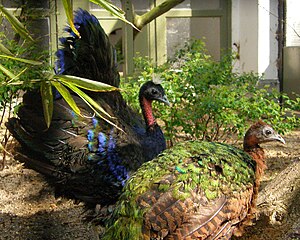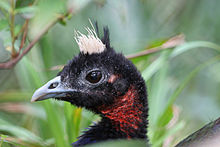Congo peacock
| Congo peacock | ||||||||
|---|---|---|---|---|---|---|---|---|

Pair of Congo peas in Antwerp Zoo |
||||||||
| Systematics | ||||||||
|
||||||||
| Scientific name of the genus | ||||||||
| Afropavo | ||||||||
| Chapin , 1936 | ||||||||
| Scientific name of the species | ||||||||
| Afropavo congensis | ||||||||
| Chapin, 1936 |
The Congo peacock ( Afropavo congensis ) is a little known bird art from the family of pheasant-like . It occurs in the northern Congo Basin . Its first description in 1936 is considered to be one of the greatest ornithological sensations of the 20th century.
features
The average body size of the Congo peacock is smaller than that of the Asian peacock. Males are 64 to 70 cm long, their tails reach a length of 23 to 26 cm. Females grow to be 60 to 63 cm long with 19.5 to 22.5 cm long tails. The weight of the birds is 1135 to 1154 grams.
Male Congo peacocks wear a white crown of feathers, which can be quite short, their necks show bare, featherless areas, the extent of which is individually different. Their adult plumage, which they only get at the age of two, is blue, black and green. Females are brown with green backs and wings.
Way of life
The Congo peacock is shy and rarely seen in the wild. It lives in lowland rainforests below 1200 meters and avoids areas that are closer than 25 km to the nearest human settlement and road. It feeds omnivorously , termites probably make up a significant part of the diet. The breeding season depends on the local rainy season. Young birds were observed 300 km south of the equator in January and February. Captive birds build their nest, which is just a concave platform, at a height of less than 1.5 meters in shrubs or trees. Usually two to three, rarely up to six eggs are laid and incubated for 27 to 28 days. The chicks have down plumage that is black to black-brown on the top and cream-colored on the bottom. Their wings are cinnamon in color.
Systematics
The Congo peacock is probably closely related to the Asiatic peafowl ( Pavo ) and forms with them and some other genera the subfamily Pavoninae. However, a relationship with the guinea fowl (Numididae) and the crocodile chickens (Cracidae) has also been suggested.
literature
- Josep del Hoyo et al .: Handbook of the Birds of the World. Volume 2: New World Vultures to Guinea Fowl. Lynx Edicions, 1994, ISBN 84-87334-15-6 .
- Walter N. Verheyen : The Congo Peacock. (= Die Neue Brehm-Bücherei. Volume 351). A. Ziemsen Verlag, Wittenberg Lutherstadt 1965.
Individual evidence
- ↑ Walter N. Verheyen: The Kongopfau. (= Die Neue Brehm-Bücherei. Volume 351). A. Ziemsen Verlag, Wittenberg Lutherstadt 1965.
- ↑ Rebecca T. Kimball, Edward L. Braun and J. David Ligon (1997): Resolution of the Phylogenetic Position of the Congo Peafowl, Afropavo congensis: A Biogeographic and Evolutionary Enigma. Proceedings of the Royal Society Series B Vol. 264, No. 1387: 1517-1523. doi : 10.1098 / rspb.1997.0210
Web links
- Afropavo congensis in the endangered Red List species the IUCN 2008. Posted by: BirdLife International, 2008. Accessed January 30 of 2009.
- Videos, photos and sound recordings on Afropavo congensis in the Internet Bird Collection
